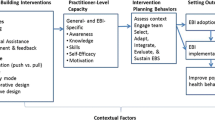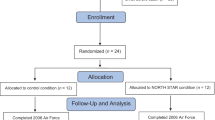Abstract
Community practitioners can face difficulty in achieving outcomes demonstrated by prevention science. Building a community practitioner’s prevention capacity—the knowledge and skills needed to conduct critical prevention practices—could improve the quality of prevention and its outcomes. The purpose of this article is to: (1) describe how an intervention called Assets-Getting To Outcomes (AGTO) was used to establish the key functions of the ISF and present early lessons learned from that intervention’s first 6 months and (2) examine whether there is an empirical relationship between practitioner capacity at the individual level and the performance of prevention at the program level—a relationship predicted by the ISF but untested. The article describes an operationalization of the ISF in the context of a five-year randomized controlled efficacy trial that combines two complementary models designed to build capacity: Getting To Outcomes (GTO) and Developmental Assets. The trial compares programs and individual practitioners from six community-based coalitions using AGTO with programs and practitioners from six similar coalitions that are not. In this article, we primarily focus on what the ISF calls innovation specific capacity and discuss how the combined AGTO innovation structures and uses feedback about its capacity-building activities, which can serve as a model for implementing the ISF. Focus group discussions used to gather lessons learned from the first 6 months of the AGTO intervention suggest that while the ISF may have been conceptualized as three distinct systems, in practice they are less distinct. Findings from the baseline wave of data collection of individual capacity and program performance suggest that practitioner capacity predicts, in part, performance of prevention programs. Empirically linking practitioner capacity and performance of prevention provides empirical support for both the ISF and AGTO.

Similar content being viewed by others
Notes
Getting to Outcomes and “GTO” are registered trademarks of the RAND Corporation and the University of South Carolina.
Developmental Assets is a registered trademark of Search Institute.
US Census 2000.
According to the 2006 Maine Youth Drug and Alcohol Use Survey (http://www.maine.gov/dhhs/osa/data/mydaus/mydaus2006.htm).
This interview is described in more detail under Measures, Program Performance.
Nine programs folded between the time the study was planned and begun, leaving only 51 programs.
References
Ajzen, I., & Fishbein, M. (1977). Attitude-behavior relations: A theoretical analysis and review of empirical research. Psychological Bulletin, 84, 888–918.
Backer, T. E. (2001). Finding the balance: Program fidelity and adaptation in substance abuse prevention: A state-of-the-art review. Rockville, MD: Substance Abuse and Mental Health Administration.
Bandura, A. (2004). Health promotion by social cognitive means. Health Education & Behavior, 31(2), 143–164.
Bartholomew, L. K., Parcel, G. S., Kok, G., & Gottleib, N. H. (2001). Changing behavior and environment: How to plan theory- and evidence-based disease management programs. In R. Patterson (Ed.), Changing patient behavior: Improving outcomes in health and disease management (pp. 73–112). San Francisco, CA: Joey-Bass.
Battelle. (2008). Annual findings report: Drug-free communities support program national evaluation. Washington, DC: Executive Office of the President Office of Administration Office of National Drug Control Policy (unpublished manuscript).
Benson, P. L. (2002). Toward asset-building communities: How does change occur? In R. M. Lerner & P. L. Benson (Eds.), Developmental assets and asset-building communities: Implications for research policy and practice. Norwell, MA: Kluwer.
Benson, P. L., & Scales, P. C. (in press). Developmental assets. In R. J. R. Levesque (Ed.), Encyclopedia of adolescence. New York, NY: Springer.
Benson, P. L., Scales, P. C., Leffert, N., & Roehlkepartain, E. R. (1999). A fragile foundation: The state of developmental assets among American youth. Minneapolis, MN: Search Institute.
Benson, P. L., Scales, P. C., & Mannes, M. (2003). Developmental strengths and their sources: Implications for the study and practice of community building. In R. M. Lerner, F. Jacobs, & D. Wertlieb (Eds.), Handbook of applied developmental science: Vol. 1: Applying developmental science for youth and families (pp. 369–406). Thousand Oaks, CA: Sage.
Benson, P. L., Scales, P. C., & Syvertsen, A. K. (in press). The contribution of the developmental assets framework to positive youth development theory and practice. In R. M. Lerner, J. V. Lerner, & J. B. Benson (Eds.), Advances in child development and behavior: Positive youth development—research and applications for promoting thriving in adolescence. New York, NY: Elsevier.
Botvin, G. J., Baker, E., Dusenbury, L., Botvin, E. M., & Diaz, T. (1995). Long-term follow-up results of a randomized drug abuse prevention trial in a white middle-class population. Journal of the American Medical Association, 273(14), 1106–1112.
Butterfoss, F. D., Goodman, R. M., & Wandersman, A. (1993). Community coalitions for prevention and health promotion. Health Education Research, 8, 315–330.
Chinman, M., Early, D., Ebener, P., Hunter, S., Imm, P., Jenkins, P., et al. (2004). Getting to outcomes: A community-based participatory approach to preventive interventions. Journal of Interprofessional Care, 18, 441–443.
Chinman, M., Hannah, G., Wandersman, A., Ebener, P., Hunter, S., Imm, P., et al. (2005). Developing a community science research agenda for building community capacity for effective preventive interventions. American Journal of Community Psychology, 3(4), 143–157.
Chinman, M., Hunter, S., Ebener, P., Paddock, S., Stillman, L., Imm, P., et al. (2008). The Getting To Outcomes demonstration and evaluation: An illustration of the Prevention Support System. American Journal of Community Psychology, 41, 206–224.
Chinman, M., Tremain, B., Imm, P., & Wandersman, A. (2009). Strengthening prevention performance using technology: A formative evaluation of interactive Getting To Outcomes. The American Journal of Orthopsychiatry, 79, 469–481.
Donner, A., & Klar, N. (2004). Pitfalls of and controversies in cluster randomization trials. American Journal of Public Health, 94(3), 416–422.
Eggert, L. L., Thompson, E. A., Herting, J. R., Nicholas, L. J., & Dicker, B. G. (1994). Preventing adolescent drug abuse and high school dropout through an intensive school-based social network development program. American Journal of Health Promotion, 8(3), 202–215.
Fetterman, D. M., & Wandersman, A. (Eds.). (2005). Empowerment evaluation principles in practice. New York, NY: Guilford Press.
Fishbein, M., & Ajzen, I. (1974). Attitudes toward objects as predictive of single and multiple behavioral criteria. Psychological Review, 81, 59–74.
Fishbein, M., & Ajzen, I. (1975). Belief, attitude, intention, and behavior: An introduction to theory and research. Reading, MA: Addison-Wesley.
Fisher, D., Imm, P. S., Chinman, M., & Wandersman, A. (2006). Getting To Outcomes with developmental assets: Ten steps to measuring success in youth programs and communities. Minneapolis, MN: Search Institute.
Glaser, B. G. (1965). The constant comparative method of qualitative analysis. Social Problems, 12(4), 436–445.
Green, L. (2001). From research to "best practices" in other settings and populations. American Journal of Health Behavior, 25(3), 165–178.
Green, L. W., Kreuter, M. W., Deeds, S. G., & Partridge, K. B. (1980). Health education planning model (PRECEDE). In L. W. Green, et al. (Eds.), Health education planning. Palo Alto, CA: Mayfield Publishing Company.
Hawkins, J. D., Catalano, R. F., & Miller, J. Y. (1992). Risk and protective factors for alcohol and other drug problems in adolescence and early adulthood: Implications for substance abuse prevention. Psychological Bulletin, 112, 64–105.
Hawkins, J. D., Oesterle, S., Brown, E. C., Arthur, M. W., Abbott, R. D., Fagan, A. A., et al. (2009). Results of a type 2 translational research trial to prevent adolescent drug use and delinquency: A test of communities that care. Archives of Pediatric and Adolescent Medicine, 163(9), 789–798.
Hunter, S. B., Chinman, M., Ebener, P., Imm, P., Wandersman, A., & Ryan, G. (2009a). Technical assistance as a prevention capacity-building tool: A demonstration using the Getting To Outcomes framework. Health Education and Behavior, 36, 810–828.
Hunter, S., Paddock, S., Ebener, P., Burkhart, Q., & Chinman, M. (2009b). Promoting evidence based practices: The adoption of a prevention support system in community settings. The Journal of Community Psychology, 37(5), 579–593.
Kegler, M. C., & Wyatt, V. H. (2003). A multiple case study of neighborhood partnerships for positive youth development. American Journal of Health Behaviour, 27(2), 156–169.
Kitson, A., Harvey, G., & McCormack, B. (1998). Enabling the implementation of evidence based practice: A conceptual framework. Quality in Health Care, 7, 149–158.
Leffert, N., Benson, P. L., Scales, P. C., Sharma, A. R., Drake, D. R., & Blyth, D. A. (1998). Developmental assets: Measurement and prediction of risk behaviors among adolescents. Applied Developmental Science, 2, 209–230.
Lehman, W. E. K., Greener, J. M., & Simpson, D. D. (2002). Assessing organizational readiness for change. Journal of Substance Abuse Treatment, 22(4), 197–209.
Miller, T., & Hendrie, D. (2009). Substance abuse prevention dollars and cents: A cost-benefit analysis (DHHS Pub. No. (SMA) 07-4298). Rockville, MD: Center for Substance Abuse Prevention, Substance Abuse and Mental Health Services Administration.
Mitchell, R. E., Stone-Wiggins, B., Stevenson, J. F., & Florin, P. (2004). Cultivating capacity: Outcomes of a statewide support system for prevention coalitions. Journal of Prevention & Intervention in the Community, 27(2), 67–87.
National Prevention Council. (2011). National Prevention Strategy. Washington, DC: US Department of Health and Human Services, Office of the Surgeon General.
O’Donnell, L., Scattergood, P., Adler, M., Doval, A. S., Barker, M., Kelly, J. A., et al. (2000). The role of technical assistance in the replication of effective HIV interventions. AIDS Education and Prevention, 12(5 Suppl), 99–111.
Rogers, E. M. (1995). Diffusion of innovations (4th ed.). New York: Free Press.
Rosenheck, R. A. (2001). Organizational process: A missing link between research and practice. Psychiatric Services, 52, 1607–1612.
Rubenstein, L. V., Mittman, B. S., Yano, E. M., & Mulrow, C. D. (2000). From understanding health care provider behavior to improving health care: the QUERI framework for quality improvement. Quality Enhancement Research Initiative. Medical Care, 38, 129–141.
Rycroft-Malone, J., Harvey, G., Seers, K., Kitson, A., McCormack, B., & Titchen, A. (2002). An exploration of the factors that influence the implementation of evidence into practice. Journal of Clinical Nursing, 13, 913–924.
Scales, P. C. (1999). Reducing risks and building developmental assets: Essential actions for promoting adolescent health. Journal of School Health, 69(3), 113–119.
Scales, P. C. (in press). Youth developmental assets in global perspective: Results from international adaptations of the Developmental Assets Profile. Child Indicators Research.
Scales, P. C., Benson, P. L., Leffert, N., & Blyth, D. A. (2000). Contribution of developmental assets to the prediction of thriving among adolescents. Applied Developmental Science, 4(1), 27–46.
Somers, C. L., & Fahlman, M. M. (2001). Effectiveness of the “Baby Think it Over” teen pregnancy prevention program. Journal of School Health, 71(5), 188–195.
Spoth, R., Redmond, C., Shin, C., Greenberg, M., Clair, S., & Feinberg, M. (2007). Substance-use outcomes at 18 months past baseline: The PROSPER Community-University partnership trial. American Journal of Preventive Medicine, 32(5), 395–402.
Stetler, C. B., Legro, M. W., Rycroft-Malone, J., Bowman, C., Curran, G., Guihan, M., et al. (2006). Role of ‘external facilitation’ in implementation of research findings: A qualitative evaluation of facilitation experiences in the Veterans Health Administration. Implementation Science, 1, 23. doi:10.1186/1748-5908-1-23.
Stevenson, J. F., Florin, P., Mills, D. S., & Andrade, M. (2002). Building evaluation capacity in human service organizations: A case study. Evaluation and Program Planning, 25(3), 233–243.
Wandersman, A., Duffy, J., Flaspohler, P., Noonan, R., Lubell, K., Stillman, L., et al. (2008). Bridging the gap between prevention science and practice: The interactive systems framework for dissemination and implementation. American Journal of Community Psychology, 41, 171–181.
Wandersman, A., & Florin, P. (2003). Community interventions and effective prevention: Bringing researchers/evaluators, funders and practitioners together for accountability. American Psychologist, 58(6/7), 441–448.
Wandersman, A., Imm, P., Chinman, M., & Kaftarian, S. (2000). Getting to outcomes: A results-based approach to accountability. Evaluation and Program Planning, 23, 389–395.
Weiss, E., Miller-Anderson, R., & Lasker, R. (2002). Making the most of collaboration: Exploring the relationship between partnership synergy and partnership functioning. Health Education and Behavior, 29, 683–698.
Wenger, E., McDermott, R., & Snyder, W. M. (2002). Cultivating communities of practice. Boston, MA: Harvard Business School Press.
Author information
Authors and Affiliations
Corresponding author
Rights and permissions
About this article
Cite this article
Chinman, M., Acosta, J., Ebener, P. et al. Establishing and Evaluating the Key Functions of an Interactive Systems Framework Using an Assets-Getting to Outcomes Intervention. Am J Community Psychol 50, 295–310 (2012). https://doi.org/10.1007/s10464-012-9504-z
Published:
Issue Date:
DOI: https://doi.org/10.1007/s10464-012-9504-z




